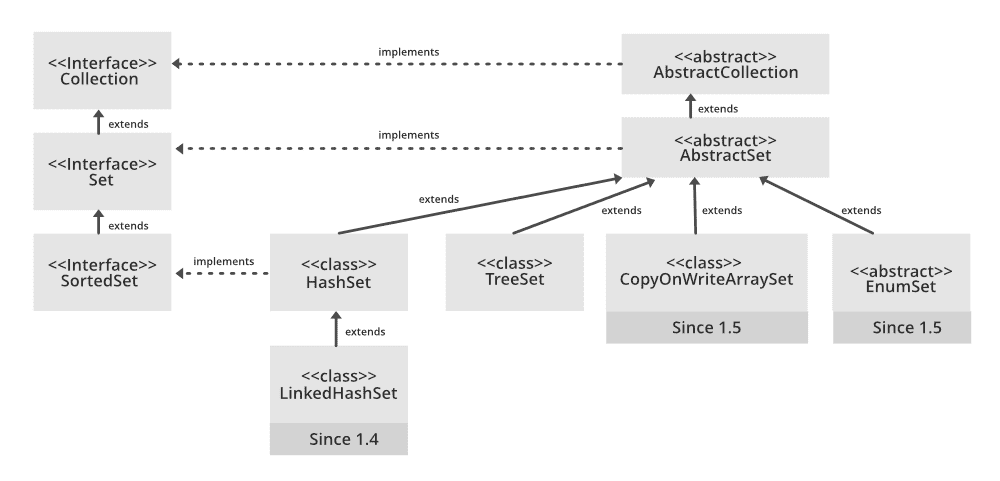这个 LinkedHashSet 是HashSet的一个有序版本,它在所有元素之间维护一个双链接列表。当需要维护迭代顺序时,使用这个类。当遍历 哈希集 顺序是不可预测的,而LinkedHashSet允许我们按照元素插入的顺序迭代元素。当使用迭代器在LinkedHashSet中循环时,元素将按插入顺序返回。
LinkedHashSet的层次结构如下:

参数: 此集合维护的元素类型
All Implemented Interfaces are as listed below:SerializableCloneable,Iterable<E>Collection<E>Set<E>
语法: 公告
public class LinkedHashSet<E> extends HashSet<E> implements Set<E>, Cloneable, Serializable
- 只包含HashSet之类的唯一元素。它扩展了HashSet类并实现了Set接口。
- 保持插入顺序。
LinkedHashSet类的构造函数
1.LinkedHashSet(): 此构造函数用于创建默认哈希集
LinkedHashSet<E> hs = new LinkedHashSet<E>();
2.LinkedHashSet(集合C): 用于用集合C的元素初始化哈希集。
LinkedHashSet<E> hs = new LinkedHashSet<E>(Collection c);
3.LinkedHashSet(整数大小): 用于使用参数中提到的整数初始化LinkedHashSet的大小。
LinkedHashSet<E> hs = new LinkedHashSet<E>(int size);
4.LinkedHashSet(整数容量、浮点填充率): 可用于初始化容量和填充率,也称为LinkedHashSet的负载容量,参数中提到了参数。当元素的数量超过哈希集的容量时,哈希集将乘以填充率,从而扩展LinkedHash集的容量。
LinkedHashSet<E> hs = new LinkedHashSet<E>(int capacity, int fillRatio);
例子:
JAVA
// Java Program to Illustrate LinkedHashSet // Importing required classes import java.util.LinkedHashSet; // Main class // LinkedHashSetExample public class GFG { // Main driver method public static void main(String[] args) { // Creating an empty LinkedHashSet of string type LinkedHashSet<String> linkedset = new LinkedHashSet<String>(); // Adding element to LinkedHashSet // using add() method linkedset.add( "A" ); linkedset.add( "B" ); linkedset.add( "C" ); linkedset.add( "D" ); // Note: This will not add new element // as A already exists linkedset.add( "A" ); linkedset.add( "E" ); // Getting size of LinkedHashSet // using size() method System.out.println( "Size of LinkedHashSet = " + linkedset.size()); System.out.println( "Original LinkedHashSet:" + linkedset); // Removing existing entry from above Set // using remove() method System.out.println( "Removing D from LinkedHashSet: " + linkedset.remove( "D" )); // Removing existing entry from above Set // that does not exist in Set System.out.println( "Trying to Remove Z which is not " + "present: " + linkedset.remove( "Z" )); // Checking for element whether it is present inside // Set or not using contains() method System.out.println( "Checking if A is present=" + linkedset.contains( "A" )); // Noew lastly printing the updated LinkedHashMap System.out.println( "Updated LinkedHashSet: " + linkedset); } } |
Size of LinkedHashSet = 5Original LinkedHashSet:[A, B, C, D, E]Removing D from LinkedHashSet: trueTrying to Remove Z which is not present: falseChecking if A is present=trueUpdated LinkedHashSet: [A, B, C, E]
在LinkedHashSet类上执行各种操作
让我们看看如何在LinkedHashSet上执行一些常用的操作。
操作1: 添加元素
为了向LinkedHashSet添加元素,我们可以使用 添加() 方法这与HashSet不同,因为在HashSet中,插入顺序不会保留,而是保留在LinkedHashSet中。
例子:
JAVA
// Java Program to Add Elements to LinkedHashSet // Importing required classes import java.io.*; import java.util.*; // Main class // AddingElementsToLinkedHashSet class GFG { // Main driver method public static void main(String[] args) { // Creating an empty LinkedHashSet LinkedHashSet<String> hs = new LinkedHashSet<String>(); // Adding elements to above Set // using add() method // Note: Insertion order is maintained hs.add( "Geek" ); hs.add( "For" ); hs.add( "Geeks" ); // Printing elements of Set System.out.println( "LinkedHashSet : " + hs); } } |
LinkedHashSet : [Geek, For, Geeks]
操作2: 移除元素
可以使用 删除() 方法
例子:
JAVA
// Java program to Remove Elements from LinkedHashSet // Importing required classes import java.io.*; import java.util.*; // Main class // RemoveElementsFromLinkedHashSet class GFG { // Main driver method public static void main(String[] args) { // Creating an empty LinekdhashSet of string type LinkedHashSet<String> hs = new LinkedHashSet<String>(); // Adding elements to above Set // using add() method hs.add( "Geek" ); hs.add( "For" ); hs.add( "Geeks" ); hs.add( "A" ); hs.add( "B" ); hs.add( "Z" ); // Printing all above elements to the console System.out.println( "Initial HashSet " + hs); // Removing the element from above Set hs.remove( "B" ); // Again removing the element System.out.println( "After removing element " + hs); // Returning false if the element is not present System.out.println(hs.remove( "AC" )); } } |
Initial HashSet [Geek, For, Geeks, A, B, Z]After removing element [Geek, For, Geeks, A, Z]false
操作3: 在LinkedHashSet中迭代
使用 这个 迭代器() 方法最著名的是使用 增强的for循环。
例子:
JAVA
// Java Program to Illustrate Iterating over LinkedHashSet // Importing required classes import java.io.*; import java.util.*; // Main class // IteratingLinkedHashSet class GFG { // Main driver method public static void main(String[] args) { // Instantiate an object of Set // Since LinkedHashSet implements Set // Set points to LinkedHashSet Set<String> hs = new LinkedHashSet<String>(); // Adding elements to above Set // using add() method hs.add( "Geek" ); hs.add( "For" ); hs.add( "Geeks" ); hs.add( "A" ); hs.add( "B" ); hs.add( "Z" ); // Iterating though the LinkedHashSet // using iterators Iterator itr = hs.iterator(); while (itr.hasNext()) System.out.print(itr.next() + ", " ); // New line System.out.println(); // Using enhanced for loop for iteration for (String s : hs) System.out.print(s + ", " ); System.out.println(); } } |
Geek, For, Geeks, A, B, Z, Geek, For, Geeks, A, B, Z,
LinkedHashSet的方法
在这里 E 是存储的元素的类型。
|
方法 |
描述 |
|---|---|
| 拆分器() | 在此集合中的元素上创建后期绑定和快速失败拆分器。 |
java类中声明的方法。util。抽象集
|
方法 |
描述 |
|---|---|
| 等于(对象o) | 将指定的对象与此集合进行相等性比较。 |
| hashCode() | 返回此集合的哈希代码值。 |
| removeAll(集合c) | 从该集合中删除指定集合中包含的所有元素(可选操作)。 |
java类中声明的方法。util。抽象集合
|
方法 |
描述 |
|---|---|
| 阿道尔(收集c) | 将指定集合中的所有元素添加到此集合(可选操作)。 |
| 康纳萨尔(收集c) | 如果此集合包含指定集合中的所有元素,则返回true。 |
| 保留(收集c) | 仅保留此集合中包含在指定集合中的元素(可选操作)。 |
| toArray() | 返回包含此集合中所有元素的数组。 |
| 托雷(T[]a) | 返回包含此集合中所有元素的数组;返回数组的运行时类型是指定数组的运行时类型。 |
| toString() | 返回此集合的字符串表示形式。 |
在java接口中声明的方法。util。收集
|
方法 |
描述 |
|---|---|
| parallelStream() | 返回一个可能与此集合并行的流作为其源。 |
|
removeIf(谓词 E> 过滤器) |
删除此集合中满足给定谓词的所有元素。 |
| 流() | 返回以此集合为源的连续流。 |
java类中声明的方法。util。哈希集
|
方法 |
描述 |
|---|---|
| 加(E) | 如果指定的元素尚未存在,则将其添加到此集合。 |
| 清除() | 从该集中删除所有元素。 |
| 克隆() | 返回此HashSet实例的浅层副本:元素本身不会被克隆。 |
| 包含(对象o) | 如果此集合包含指定的元素,则返回true。 |
| isEmpty() | 如果此集合不包含任何元素,则返回true。 |
| 迭代器() | 返回此集合中元素的迭代器。 |
| 移除(对象o) | 从该集合中删除指定的元素(如果存在)。 |
| 大小() | 返回此集合中的元素数(其基数)。 |
在java接口中声明的方法。lang.Iterable
|
方法 |
描述 |
|---|---|
| 对Iterable的每个元素执行给定的操作,直到所有元素都已处理或该操作引发异常。 |
在java接口中声明的方法。util。设置
| 方法 | 描述 |
|---|---|
| 添加(元素) | 此方法用于向集合中添加特定元素。仅当指定的元素在集合中不存在时,函数才会添加该元素;否则,如果元素在集合中已存在,函数将返回False。 |
| addAll(集合c) | 此方法用于将上述集合中的所有元素附加到现有集合中。元素是随机添加的,不遵循任何特定顺序。 |
| 清除() | 此方法用于删除集合中的所有元素,但不删除集合。集合的引用仍然存在。 |
| 包含(元素) | 此方法用于检查集合中是否存在特定元素。 |
| CONTANSALL(c系列) | 此方法用于检查集合是否包含给定集合中的所有元素。如果集合包含所有元素,则此方法返回true;如果缺少任何元素,则返回false。 |
| hashCode() | 此方法用于获取集合的此实例的hashCode值。它返回一个整数值,该整数值是集合的这个实例的hashCode值。 |
| isEmpty() | 此方法用于检查集合是否为空。 |
| 迭代器() | 此方法用于返回集合的迭代器。集合中的元素以随机顺序返回。 |
| 移除(元素) | 此方法用于从集合中删除给定元素。如果集合中存在指定的元素,则此方法返回True,否则返回False。 |
| removeAll(收藏) | 此方法用于从集合中删除集合中存在的所有元素。如果此集合因调用而更改,则此方法返回true。 |
| 保留(收藏) | 此方法用于保留给定集合中提到的集合中的所有元素。如果此集合因调用而更改,则此方法返回true。 |
| 大小() | 此方法用于获取集合的大小。这将返回一个表示元素数的整数值。 |
| toArray() | 此方法用于形成与集合相同元素的数组。 |
| 托雷(T[]a) | 返回包含此集合中所有元素的数组;返回数组的运行时类型是指定数组的运行时类型。 |
以下是两者之间的区别 LinkedHashMap 和LinkedHashSet:
| 类别 | LinkedHashMap | LinkedHashSet |
|---|---|---|
| 活动 | Usd用于存储键值对。 | 用来存放物品的集合 |
| 复制品 | 获取唯一的密钥,无重复的密钥,但可以获取重复的值 | 不存储重复的元素 |
| 工具 | 哈希图 | 哈希集 |
| 实例 | Map |
Set |
注: 在LinkedHashmap和LinkedHashset中保持插入顺序会带来额外的相关成本,包括额外的CPU周期和需要更多内存。如果不需要维护插入顺序,建议使用较轻的重量 哈希集 和 哈希图 相反
本文由 普拉蒂克·阿加瓦尔 .如果你喜欢GeekSforgek,并想贡献自己的力量,你也可以使用 写极客。组织 或者把你的文章寄去评论-team@geeksforgeeks.org.看到你的文章出现在Geeksforgeks的主页上,并帮助其他极客。如果您发现任何不正确的地方,或者您想分享有关上述主题的更多信息,请写下评论。


![关于”PostgreSQL错误:关系[表]不存在“问题的原因和解决方案-yiteyi-C++库](https://www.yiteyi.com/wp-content/themes/zibll/img/thumbnail.svg)






